Understanding Abstract Art
The world of art is one that is ever-changing; continuously developing as the world does. A student studying art history will find their studies reaching every time period; from pre-history all the way to the most recent artists. In earlier art history you find artists like Francisco Goya and Gustav Courbet, whose works are very much in a realistic style: their subjects discernible, needing obvious talent and work to complete. In the world of contemporary art, we find artists like Henri Matisse and Barnett Newman whose works consist of abstracted figures, blocks of solid color, and simple lines. To a viewer who has not studied these works, there is certainly a learning gap. A gap which can hinder the viewer’s ability to fully enjoy the works that deserve the same admiration as a Jan Van Eyck.
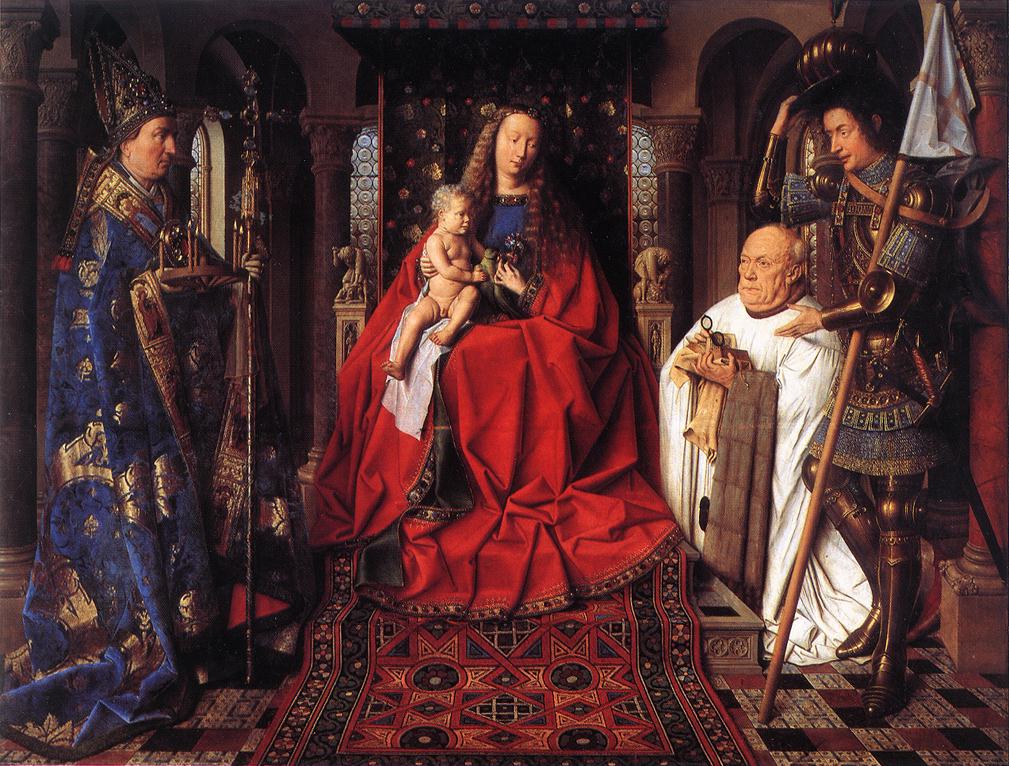
Oil on oak panel
141 x 176.5 cm
Groeningemuseum, Bruges
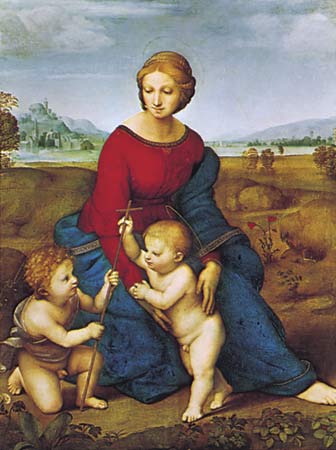
Oil on wood
Kunsthistorisches Museum, Vienna
When approaching a piece which consists of color blocks, simple shapes, simplified figures, and a subjective approach to art, many viewers become closed off to the piece. It becomes difficult to see these pieces as art when the typical representation of art is what one might find in the Renaissance period. For an outsider to the world of art, one might simply walk past a Josef Albers refusing to acknowledge a piece they claim they could create themselves and appears to require no talent to produce. It is not terribly difficult to understand this stance, especially when we learn that to master art is to master realism. To be able to create a direct copy of a person or object on a canvas is the best way to receive praise from your teachers and peers.
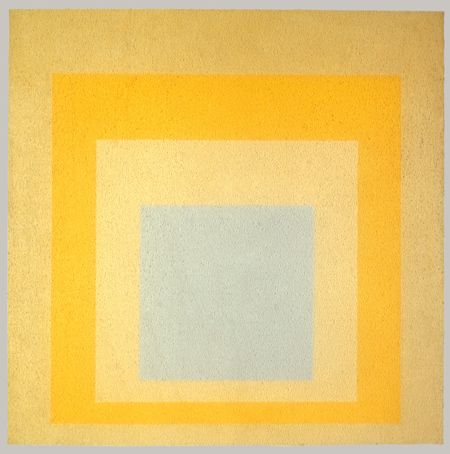
Oil on masonite
121.9 × 121.9 cm
The Met, New York
What is Art? And What Makes it Abstract?
Understanding the different ways to approach and criticize art is important when attempting to understand abstract art. It is easy to appreciate a Van Eyck or Raphael as it takes obvious skill and mastery to take a person’s likeness and brush it perfectly on a canvas. However, in order to appreciate abstraction our focus should not be on realism rather on how successful a piece is in evoking emotion and the individual elements of art: color, shape, line, texture, space, value, etc. The Oxford Dictionary defines art as “the expression or application of human creative skill and imagination, typically in a visual form such as painting or sculpture, producing works to be appreciated primarily for their beauty or emotional power.” By this definition, abstract art could be considered one of the highest forms of art.
More often than not, abstract art does not attempt to guide the viewer in any direction in terms of their response. There is no use of carefully chosen iconography that has set meanings to analyze. Abstract artists make use of the most raw elements of art and the assumption that viewers will derive their own meaning. This idea is often puzzling. For an artist to create an image which is not meant to generate a specific response can often be interpreted as lazy or depth less. This incorrect assessment hinders the viewer from exploring their personal interpretations of the art.
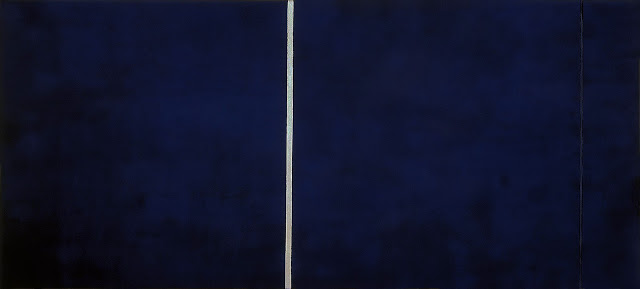
Oil on Canvas
243 x 543 cm
Stedelijk Museum, Amsterdam
The Importance of Exploring Self
In order to fully understand and appreciate abstract art, a viewer must be willing to be fully absorbed by the elements of a piece and willing to explore their own psyche. To stand in front of a Rothko, surrounded by white walls, and become fully engulfed in color, line, and texture can be an emotional experience if a viewer is open. Stand in front of the piece without trying to evaluate the quality of brush stroke or trying to scrutinize what objects are attempting to be represented. When you can look at a work and allow yourself to respond emotionally to the artistic elements you can fully enjoy abstract work.
It’s all about emotion and an individualized response. One viewer may see a piece like Barnett Newman’s Cathedral Magna and feel a sense of loneliness, seeing the middle white line engulfed in a sea of dark blue hue with black beginning to seep in as a thin grey line nearly disappears to the left of the canvas. Another viewer looking at the same piece may feel an intense sensation of hope and spirituality, reading the blue hue as a calming sea brightened by a sliver of pure white growing in the middle of the canvas as the grey line (perhaps interpreted as despair) fades away. Abstract art isn’t necessarily learning about the artist, a figure, an object, or a story, its learning about oneself but can offer up information about the artist or history in some instances.
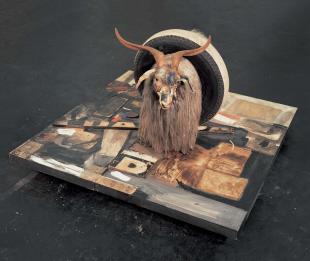
Combine: oil, paper, fabric, printed paper, printed reproductions, metal, wood, rubber shoe heel, and tennis ball on canvas with oil and rubber tire on Angora goat on wood platform mounted on four casters
42 x 63 1/4 x 64 1/2 inches (106.7 x 160.7 x 163.8 cm)
Moderna Museet, Stockholm
Individualized Response
Artists like Rauschenberg and Johns create pieces that arguably have distinct meaning but also allow for interpretation. A piece like Robert Rauschenberg’s Monogram is interpreted by some art historians as being related to the artist’s personal life and his sexuality as a gay man. While it has this meaning to the artist and to those who have previous knowledge of the artist, it can find completely new meaning within the interpretation of other viewers. A viewer could see this piece as commentary on the way the human race negatively affects the environment. Just as the personalities found within the human race are vast and unique, interpretations of art are vast.
The same goes for a piece like Jasper John’s 1967 Flag. One may interpret the piece as an artistic display of patriotism while another will interpret it as a display of the corruption of the original American ideals and another will see it as a display of the rough history and battles America has faced. There are no set meanings, and that makes abstract art very successful in evoking emotion. It doesn’t try to force a viewer in any direction, it allows a viewer to be led by their own psyche resulting in a more powerful and authentic response. A piece can make the viewer immensely happy, calm, dismal, offended, confused, etc. The viewer doesn’t necessarily have to enjoy a work of art so long as they have felt something as a result of being exposed to the piece.
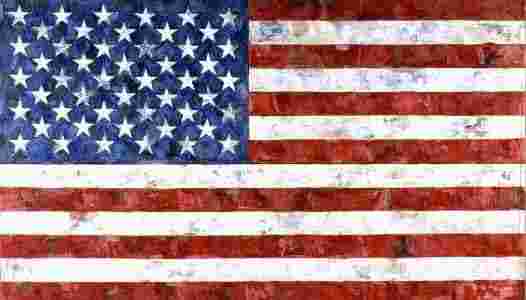
encaustic and collage on canvas (three panels)
33 1/2 x 56 1/4 in. (85.09 x 142.88 cm)
The Broad, Los Angeles
Art doesn’t have to be realistic and it doesn’t have to be beautiful but it does need to make the viewer feel something and in order for that to happen, the viewer must be open. Enter a museum with no reservation, open-minded, and willing to explore yourself. Then you can fully experience abstract work. Whether you enjoy it or not is up to you.
What do you think? Leave a comment.











The best art is abstract. Precisely because of its lack of defineable meaning. This is precisely why music is the most profound art, music at its least abstract, is many times more abstract than painting or sculpture at its most abstract. Meaning is for words. Art which uses no words, and yet attempts to convey a definate meaning is paralysed by its own compromise, and because of this, falls flat.
I do agree. The best art is where the viewer forms his own meaning. I don’t think this is restricted to just paintings or even music. I do believe even words have the same power.
I’m an art history student currently studying 20th century art, and I bloody hate abstraction. It’s so difficult to write about; 2 lines and you’re done. There is no substance, no depth, nothing to sink your teeth into.
It’s the inner most feelings of an artist. He may have been feeling a certain way … or saw something beyond the white canvas and wanted it to react to just the simple line. Have an open mind and you can discover something more than what you can see. See beyond that line and you will discover something about the Artist and yourself. He wants you to use your imagination, build upon it.
I started an oil painting course at the university last year and recently I attended my final class. The last module was about abstract painting and I thoroughly enjoyed it (as well as all the other modules). At the age of 65 I discovered Han Hofmann – what a painter and teacher he was! I have had an interest in art for about 30 years and always kept an open mind. There is much in all art – the problem is most people are not willing to stop, look and really think about what they are lookin at. They are too ready to dismiss what they do not understand and most times cannot give a coherent answer as to why they do not like a particular piece of art. To the sceptics, all I would say is embrace it all, you never know, you may surprise yourself.
I’d liken abstract expressionism to free jazz; those who get it can sometimes affect a certain holier-than-thou attitude, whereas those who don’t get it often use the Emperor’s new clothes argument. The former can seem wilfully obtuse or gullible; the latter often seem threatened by art-forms to which no apparent “rational” order can be ascribed.
I think increasingly, though, there’s room for both the abstract and the concrete in the cultural mainstream.
Abstracts, like any other genre, need to be evocative for the individual to be appreciated. I should think that having experience with art is a good grounding, but in my humble opinion, not entirely necessary.
I feel like this article is conflating abstract and non-representative art into a single meaning while talking about non-representational art.
Agreed
It’s all about play and sense of place, order, rightness, and joy, things that cannot be expressed in words.
Abstraction used to be good because the artist had at their a discipline. Now any fool who throws paint at a wall considers or is considered by others an artist. One can fake it, but at the end of the day it’s the hard work and dedication that really pays off. That goes for most things.
Great piece. Abstract Art, as is all Art, is an expression of the self. The ‘self’ is a complex entity whose expression can be beyond those who are not experienced in being aware of its powerful capacity to express itself in ways that are not apparent to the naked eye, or should I say the average eye… BUT! in saying that, the beauty, is in the eye, of the beholder. It would be far easier to write a book called: Abstract for Dummies, or something.
It’s possible to like a range of art, it is human endeavour in visual form, and says something about us as humans. The problem is translating visual representation into words.
Abstract art is less appreciated than representational art.
Abstract art is actually far more representational of reality than so-called representational art!
99% of abstract art that I’ve seen subsequently has been tosh.
Abstract art tends to the express the visceral components of human experience, such as emotions and the ineffable. It seems these components of reality are somewhat oppressed by our society, whereas the rational mind is heralded as the holy grail and thus maybe we have become so far removed from our emotions that we have an inability to see beauty beyond meaning.
All art is subjective use your eyes to decide what you like and why. Abstract art is my favorite.
I argue that since art is projection both in painting and viewing, that when you say you feel you are seeing the shape of the universe itself, you are in fact experiencing being deeper in contact with yourself.
Sadly abstraction in painting has long since lost its power to shock, or confront the viewer.
Wander round a gallery now and you see acres of ‘vague gestures’, or ‘happy accidents’ or the ‘affected gesture’.
Worst of all is the Rothko school of abstrtaction, ‘ draw a box, fill it in, repeat ad nauseum.
Abstrtaction has become safe, commercial galleries like them because they are easy to live with, and suit most domestic environments. You can even buy them in John Lewis.
If you want challenging work, look at figurative paintings. If you want really challenging try narrative painting.
I think there should be a balance between the various elements involved in a work of art: inspiration, concept, symbolism, expression, etc. Abstract Expressionism and conceptual art indulge too much in only one of these elements with a very jejune result.
A highly talented musician once said to me, half laughingly, half musingly, that no matter how far afield you go, somehow you always keep coming back to the same ten guys…
The same is true of painting, in my opinion. It isn’t as if a a lot didn’t happen of immense value after Mozart, or after Leonardo and Rembrandt – its that so many seem to feel that the latter cancels out the former, and the former are often the shoulders of giants on whom we stand.
All art is a continuum – in fact, Bach and Mozart made Steve Reich and Dohnanyi and possible; Rembrandt and Da Vinci and Titian and Velasquez made Van Gogh and Cy Twombly possie.
Everything need not appeal to all tastes, but some semblance of standards and resistance to artistic ideology should be striven for.
Abstract expressionism is the last redoubt of the terminally hip. A bastion of parochial creativity that eschews meaning for impact. I’ve tried and failed to view the genre as challenging and disruptive; forced to conclude it is little more than an exercise in self-indulgence. Fancy painting in the dark at night to separate the eye from the hand. Utter nonsense.
Excellent article
My favourite abstract paintings are the Rothko Seagram Murals (at tate modern), which have certain general representational qualities – a sense of depth, iconography, but overall their resonance is overwhelming. I like a bit of Barnett Newman too. I like the freedom that abstraction offers, the sensations, the wonder, rhythm and patterns. I like not being locked-in to a specific visual construction that occurs in figurative painting (I do also enjoy doing a spot of observational drawing). Gerhard Richter is also a favourite, his work is stunning. Britain’s underrated Ian McKeever, I f**king love it.
All art is abstract not just abstract art. Something is not real just because it looks so or because you can recognize it. The notion of art as it is can be only abstract.
I’ve always thought most people love abstract art! So easy on the eye and full of colour and absolutely full of decorative potential. I’ve always found that it’s figurative art that provokes strong old fashioned opinions on correct drawing and proportion and perspective etc etc.
Nice article. it helps to make abstract art more approachable for somebody not familiar with the workings of the art world.
Its very simple … Abstract art is visual music .. good or bad thats what it is …
Great piece. Abstract Art, as is all Art, is an expression of the self.
I think you’re right that people struggle with abstract work, but that’s largely because abstraction is seen as a massive leap from representation or realism, when in fact it’s better understood as a development.
Exhibit A: JMW Turner’s late paintings were abstract in everything but name.
There is one type of abstract expressionist painting I love … the type that children produce, because, in my opinion, it is the only honest form of abstract expressionist art in existence.
This is my favorite comment.
Beautiful piece. I’ve never evaluated abstract art on its ability to evoke a feeling and stimulate self-reflection. These elements surely bring merit to the abstract genre of art.
Excellent piece; while I appreciate both Western classical art and Abstract art I feel your definition of the animus of Abstract is on point. “Abstract art isn’t necessarily learning about the artist, a figure, an object, or a story; it’s learning about oneself but can offer up information about the artist or history in some instances.”
I do agree entirely. Abstract art is special and allows viewers to think outside of the box.
i totally can relate to art now!
I find that poetry is written abstract art. So many people allow themselves to get stuck in the language that they don’t pay attention to their emotions to the poem itself. You don’t need to immediately think about poetry; enjoy it first, then go deeper.
Perhaps we should be taught to appreciate abstract art like “Homage to the Square: With Rays” prior to more complicated works that include people and landscapes.
Art is meant to be felt. Even though some persons think they don’t understand a piece of art, the actual feeling that they get is the true understanding.
Art does evoke a response. Usually a difficult topic but you have written a piece with clarity.
A short and simple article with some well put points! I never understood abstract art while I was growing up and being taught about those artists in school. I was told to appreciate it while I was also driven away from it because teachers can’t assess that style accurately. Your explanation of letting it be the sole thing around (displayed in a gallery) as to evoke an emotional response rather than an analytical one is very intriguing and I’d like to give abstract art another chance should I get to view any in that format. In the mean time though, pictures online must not do most abstract works justice and surely glancing at them on a slideshow in a classroom doesn’t either.
What a fantastic article! It’s interesting to trace this line even further into the “why.” I have found that entering a museum with an open mind is easier for artists than for most people who do not, themselves, create in some medium or other (this could mean an artistic mechanic, chef or mathematician, not exclusively a visual artist) The fear of being wrong is often the culprit. In our society that is so frequently based upon filling a square with one distinctly, quantifiable answer, there is a general socialization that disallows for fluidity, interpretation and the grey-area of choice. I love that your article is guiding people to approach an experience with less fear and more options.
I agree. The openness of the viewer critical in understanding the work. So many viewers see art and say “I don’t get it” and simply move on. To “get it,” one must be open to “getting” it.
Abstract Art is one of the most fascinating art movements. John Olsen is my favourite abstract painter. A wonderful article!
Post-modernism embraces abstract ideas of creation rather than the concert expression (lines and patterns) of the artistic forms…I somewhat agree with what Danto’s said that “art is dead after 1964”. Post modern arts are chaotic and discrete, or maybe it’s just too hard for me to get to the point…..
This one of my favorite movements of art. Thank you for sharing thin great article.
I think its quite narcissistic and ego-stroking to just go to an abstract art gallery and walk around thinking and feeling whatever comes to mind and whatever you feel like. Why not just go to a bathroom fittings showroom and look at yourself in all the mirrors?
So glad I’ve come across this piece as I’ve always wanted to be able to appreciate abstract art but didn’t quite know how or why it wasn’t intuitive! Giving examples of interpretations was really helpful too as I realised that it’s merely a form of abstract symbolism that we can interpret however we want – kind of like inkblot tests!
People often say: “I could have painted that”.
My immediate response to such comments is: “Why didn’t you? “
the realm of abstraction is so broad and diverse that writing about it becomes rather precarious. Speaking about abstract art as a genre is strange in the sense that, for example, a work which consists of a line on a blank canvas has almost no relation to a complex abstract installation piece. I personally think that like all genres of art abstract art has the ability to go from some very average and self-indulgent ego stroking to deep explorations of the human condition. I think we must be weary of falling victim to being afraid to dislike a piece of art.
I study at the most wankish of art schools, and am friends with one teacher in particular who is hyperaware of the ridiculousness of ‘abstract’ (in quotations, because truly, it isn’t abstract, it’s just the best job a bunch of government-funded theatre-making cocks could do at amking any kind of remotely avant-garde bullshit). We watched these highly-acclaimed theatre makers and their equivalent to on-stage masturbation, and while fun, still redefines this genre of art as something easy to take the piss out of and miscalulated dramaturgically. But then again- so what? Who cares? And THAT is the pinnacle of abstract art. It isn’t about what is seen but what is taken. So either that theatre ensemble were really smart or really, really stupid.
Art in anything exists merely in the mind which contemplates them. We are all artists, it is just that each of us attracts and is attracted to differing (counts of) beings. Both emotions and aesthetics are the concepts that are quite different from ‘rational’ thinking. Interestingly, these phenomena appear to be in discernible consonance with several highly rational scientific and engineering principles (such as uncertainty principle, and significant digits in metrology).
‘For an artist to create an image which is not meant to generate a specific response can often be interpreted as lazy or depth less. This incorrect assessment hinders the viewer from exploring their personal interpretations of the art.’
I find this quote especially poignant in your piece as this is the common misconception of abstract art. The age old ‘that’s just a splash of colour or a common shape, I could do that’ really does fail to properly grasp the artist’s intentions when creating abstract art, and also the entire existence of abstract art itself.
It was, and is, a rebellion, first and foremost, against restriction and prediction. A noble pursuit that can be easily misunderstood by those who don’t first understand this, and only see the art without its surrounding context.
In one way abstract art is really only for people interested in it. Those who aren’t often don’t appreciate it at all and have little understanding. They just see a picture of four squares and say “I did that in kindy”. These people often don’t seek more context or connectivity to the artwork and therefore don’t appreciate it for what it is
I grew up loving art and then lost my passion for it as I didn’t have anyone around to encourage and inspire me. Since then, I’ve seen art as a difficult thing. This piece was helpful in debunking that notion.
Beautiful art, great article.
What I love about Abstract art is that is so personal to the individual., and enable you to have varying degrees of emotion which can transpire to a great conversation or debate. We are not told by the artist what to feel or see, hence the experience is very individual for each person to enjoy. Notably this can vary throughout our life as we evolve and grow and gain world knowledge. art can evoke different emotions at varying stages of our life.
In today’s society consider the thousands of $$ that are paid in the purchasing of white blank canvas’s, maybe Freud’s theory has being conceptualized in the form of abstract art and it;s ones perception and construct of the mind that presents the art as being abstract or not.
I think that the idea that it is up to us to appreciate abstract art is so poignant in so many things – especially in the ability to accept and enjoy art. To come to a piece of art already cynical what can you expect to receive apart from a negative experience? Just as if you expect your day to be boring, and uneventful the likelihood of this being true is greatly increased.
I love abstract art!!!
An interesting point raised in this piece is the imperative of the viewer of an abstract artwork to be willing to wade through the ‘easily dismissible’ rawness to find something in it that resonates with them. I agree that a bit of self-archaeology is necessary to find something stimulating and worthwhile in abstract art (perhaps in anything, really), even if that something is the conclusion that it is indeed egotistical masturbation – why does the artist feel the need to masturbate their ego all over the walls of this here gallery? I am reminded of a quote by Ad Reinhardt who addressed this by saying that abstract art will “meet you halfway, but no further”. This is particularly relevant in light of his paintings which appear as totally black canvases, but are actually ever so slightly tinted with primary colours; thus, it takes time for the viewer’s eyes to physiologically adjust and witness the colour emerge from the canvas. If I was to extrapolate a statement from that, it could be that Reinhardt is asking us to exercise a degree of perseverance and take the time to really look at and contemplate what is before us. If we are successful in this something that was not perceptible before may make itself known.
But I guess art depends on how you look at and what you choose to bring to it. I think you could find something profound in the work of Warhol even though he himself would claim that it was all plastic and surface and a great way to make money and meet fame. But, could the repetitive imagery of mundane consumer products (celebrities included?) be considered an implicit political statement on the Zeitgeist he found himself in? A comment on what he himself and the culture around him valued? Was he just playing the art-game as a highly public figure to make the art-game known? Maybe the artsy educated folk around can help me out with this.
A well-written article!
I really appreciate your reassertion of the personal and subjective approach to art! I agree with you. The challenge with abstract art is that there is to right or wrong answer and viewers need to create their own sense of understanding. This often takes a sense of confidence that most viewers (and artists) lack. Just because somebody *could* have created a similar artwork doesn’t mean that the artwork lacks value, because that person did not create it.
A well-structured article where you have led the reader through the ideas, with examples, and clearly outlined your points.
Excellent explanation of how to engage with abstract art.
Excellent!
It is not necessary to see a figure inside a painting to identify with it, I think abstract art goes beyond the beautiful, it is a matter of interiority, to express what is felt and to transmit it in an excellent way, for my Gabino Amaya Cacho a Spanish painter does it with his paintings of abstract pointillism, as he uses so many colors in a clean way that is seen much light, in addition to that his depth often resembles movements.
Love this. Abstract art definitely leaves the interpretation up to the viewer, and can evoke many different responses.
Beautiful Abstract Art.
Thank you!…abstract art, as an artist for some people hard explain. In order to experience a world that is not based on images that you see, it builds greater knowledge and emotion into the piece. The piece becomes unique, uncopied, a piece that comes within you, it’s as if a new star in the universe has been discovered. What was not there before was invented by you that very instance that you place your brush on the canvas. It brings a sense of being, in the moment with your own thoughts and intimacy towards the tools that are used and your inner self. Expression of your current emotions at that moment that can be a breakthrough; a work that becomes more personal and it’s part of you and most of the time for me becomes priceless. It’s like a poets collection of poems; building the foundation of your dna on canvas and you wish to pass it on to your family or people that you are close to. Yes, artist also want to make money and build to be known, but the process and the finish product it is a discovery of a new invention to the artist. That piece of abstract art if you love it most likely you would like to keep it in your collection. Then there’s others you may feel are not as successfull to you and they may be beautiful to others, hopefully a buyer. 😉 ♡♡♡
Why not mention that in Abstract Art, the design elements can produce feelings in the viewer and may have been intended to do so by the artist. We do not know what the artist’s intent was when he or she created the work of art. Perhaps, it was the artist’s intent that the abstract design elements themselves would create feelings by the nature of the line, shape, and color. Although it is true that many works of art are able to make the viewer project feelings and emotions from his or her own psyche.
I love abstract art and the fact that it is so open to the viewers
I always assumed all abstract art is not created equally, some can stick with a person seeing a piece while other pieces are quickly forgotten.
Very beautifully explained what is abstract art.
I love the abstract art style. It is nonobjective or nonrepresentational art where the artist creates a composition using shapes, lines, form and colors.
I understand the importance of emotional impact to art evaluation but am curious as to what other factors should be considered. Should any abstract image that affects me emotionally, regardless of the artist’s training and skill, be considered great art?
Brilliant article.
The ability to elicit new imaginative thoughts and understanding within the viewer, especially when the viewer doesn’t quite know it yet, is what makes abstract art so remarkably powerful.
“Then you can fully experience abstract work. Whether you enjoy it or not is up to you.”- In most cases, abstract art gives us very little choice in the matter.
Abstract art is a challenge. This article is very useful, articulate and informative.
“It’s all about emotion and an individualized response.”
From a musical point of view, I am someone who loves showing close friends my favourite songs and asking what they think – so often, people are intent on labelling: ‘doesn’t this song make you feel depressed’ etc. Even with songs with lyrics bearing a seemingly explicit message, I can take something totally different because of the mood of the music those lyrics are set against…
My bandmate/co-songwriter always refused to reveals his interpretations behind song lyrics and I am increasingly understanding why… this need to allow for an individualised response.
However I sometimes struggle to square this with the ‘function of Art’ – coming from another Artifice article about the importance of creative writers describing their ideals societies.
Perhaps there is a spectrum of Art between restricted vs open interpretability; it depends on the intention of the Artist and how much they dial up the obviousness of their work… and abstract painters will necessarily fall on the Open end of the spectrum.
Your emphasis on affect is really interesting. Can the same be said about modernist poets like Xavier Bóveda who write poems that articulate the sounds of a train, for instance? Is there a difference in the sort of affective response that is evoked in abstract painting vs. modernist poetry or any other medium?